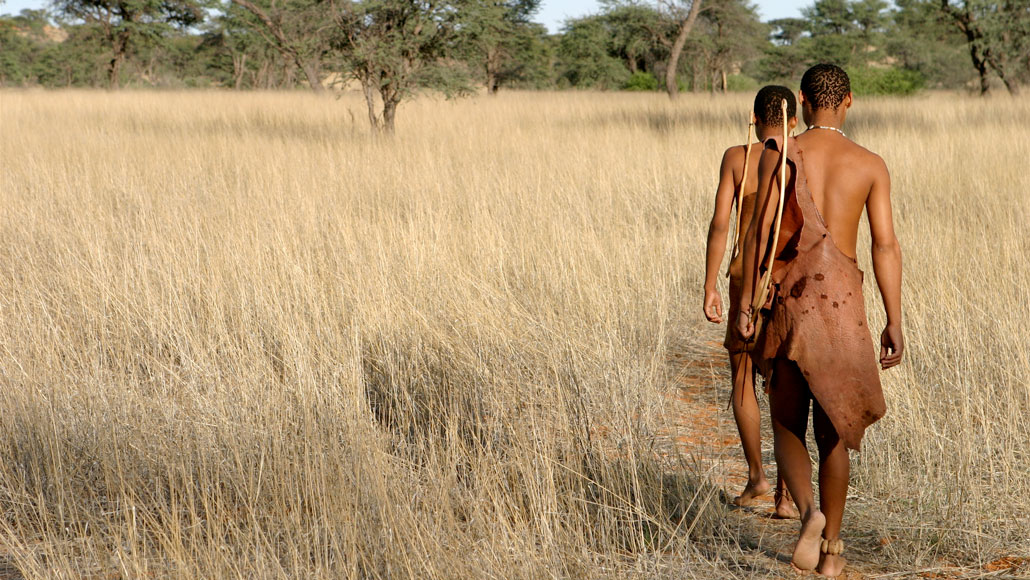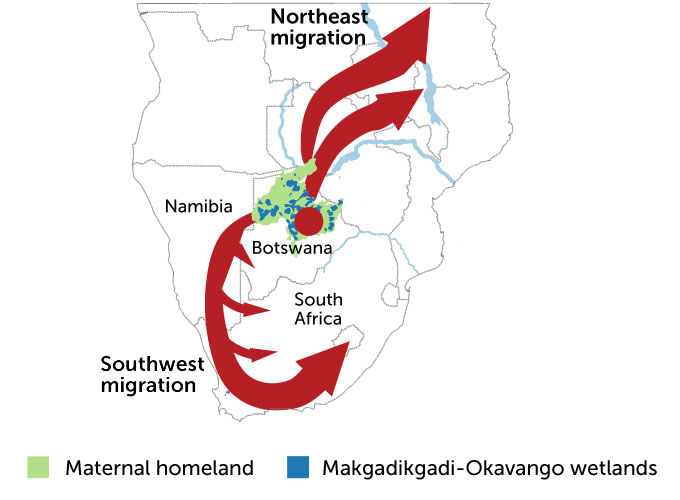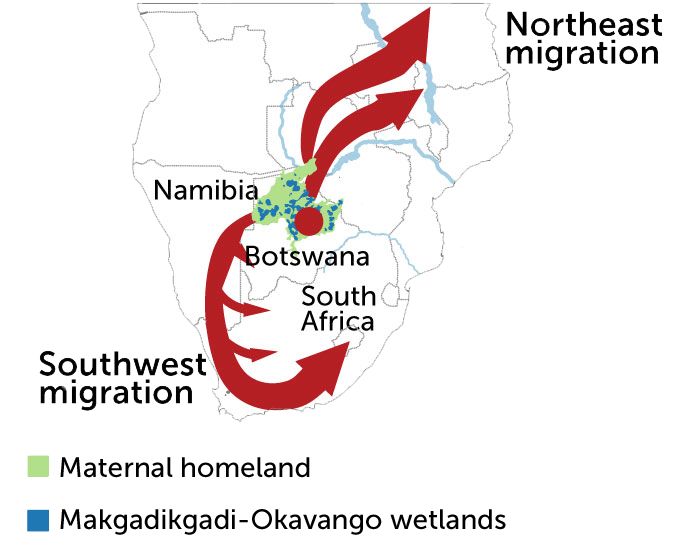
Members of southern African foraging groups, like these San hunters, possess DNA indicating that their maternal roots go back around 200,000 years to an area of what’s now northern Botswana, researchers say.
topofmind/iStock/Getty Images Plus
Humankind’s maternal roots extend back about 200,000 years to what was then a lush region of southern Africa, a study suggests. But these results highlight how much remains unknown about human origins.
Examining variations in a type of maternally inherited DNA, scientists concluded that the founding maternal line of Homo sapiens arose in what’s now northern Botswana. Then around 130,000 years ago, some members of that group migrated in two waves to East Africa via a vegetated corridor created by increased rainfall, the researchers report. Until then, that corridor was arid and sparsely vegetated. Those East African migrants may have eventually given rise to early herding and farming groups there.
A second population pulse out of the maternal homeland moved southwest, all the way to the southern tip of Africa, by around 110,000 years ago, while some members stayed behind, geneticist Vanessa Hayes and colleagues report online October 28 in Nature.
As in the previous migration, climate data indicate that wetter conditions created a green pathway for people to traverse. Southern migrants became specialists in hunting and gathering along the coast, the scientists speculate.
Leaving home
New DNA analyses suggest that, around 200,000 years ago, a founding maternal line of Homo sapiens (red circle) emerged in a region (green) of what’s now Botswana that was home to the ancient Makgadikgadi-Okavango wetlands (blue). Members of that population migrated northeast and southwest between 130,000 and 110,000 years ago.
Mapping humans’ maternal roots


“Everyone alive today goes back genetically to one maternal starting point in southern Africa,” said Hayes, of the Garvan Institute of Medical Research in Sydney, in an Oct. 24 news conference. Geologic and archeological evidence suggest that the homeland was characterized by vast, ancient wetlands that allowed humans to thrive there for about 70,000 years.
But the question of how, when and where H. sapiens originated remains far from settled.
That’s because Hayes’ team examined only mitochondrial DNA, which represents a tiny fraction of human ancestry, says archaeologist Eleanor Scerri of the Max Planck Institute for the Science of Human History in Jena, Germany.
Ancient folks who possessed forms of mitochondrial DNA that managed to get passed to people today were not the only people living in Africa 200,000 years ago or earlier, Scerri emphasizes. So only studies of entire genomes (SN: 9/28/17), or at least analyses of nuclear DNA, can provide reliable glimpses of ancient human origins, she argues. In contrast to mitochondrial DNA, nuclear DNA is inherited from both parents and would provide clues to the timing and location of humankind’s paternal roots.
Researchers will need to extract ancient DNA from human fossils to determine whether southern African foraging groups today are related to people who lived in the same region 50,000 or 200,000 years ago, says geneticist Sarah Tishkoff of the University of Pennsylvania. And numbers of East African foragers are now so small that mitochondrial DNA can’t resolve the age and location of their maternal roots, leaving a big question mark about humankind’s maternal evolution, Tishkoff says.
Sign up for our newsletter
We summarize the week's scientific breakthroughs every Thursday.
Taking available archaeological, fossil and DNA evidence into account, present-day H. sapiens probably originated from mating among human groups all across Africa that had different mixes of skeletal traits (SN: 12/13/17), beginning around 300,000 years ago, Scerri argues.
“It’s possible, even likely, that [multiple] geographic centers contributed portions of their heritage to build our genome, which cannot be addressed by mitochondrial diversity alone,” says geneticist Rebecca Cann of the University of Hawaii at Manoa.
But the new study provides crucial support for evidence that the roots of human mitochondrial DNA extend back as early as 200,000 years ago in sub-Saharan Africa, Cann says. She and colleagues reported the first mitochondrial DNA support for that scenario in a landmark 1987 paper. Cann’s group concluded that living people’s mitochondrial DNA stemmed from one woman, popularly dubbed “mitochondrial Eve,” who lived in Africa about 200,000 years ago. But it was unclear where she originated and how subsequent human migrations from there might have occurred.
Hayes’ team studied a rare form of mitochondrial DNA, known as L0, which is today largely restricted to the Khoisan people of southern Africa. Khoisan consist of separate populations of herder-gatherers and hunter-gatherers who speak languages containing “click” consonants. Over the last decade, researchers have determined that L0 has far more ancient roots than other forms of mitochondrial DNA that have been inherited by living people.
The researchers collected L0 mitochondrial DNA from 198 indigenous people living in southern Africa, mainly Khoisan. Adding in previously published samples, Hayes’ group analyzed L0 mitochondrial DNA from a total of 1,217 people.
Mitochondrial DNA accumulates changes slowly over many generations. Based on numbers of mitochondrial DNA alterations to samples from different parts of southern Africa, the scientists calculated how long ago and approximately where each L0 variant originated, revealing the ancient migrations and the ancestral homeland.
Comparisons with geologic data and computer simulations of ancient climate shifts corroborated the genetic evidence for the timing of migrations out of that homeland, the researchers say.
While the proposed homeland region is more arid and sparsely populated today, it contained small lakes and abundant vegetation that supported a variety of animals along with humans between 200,000 and 130,000 years ago, Hayes says.







